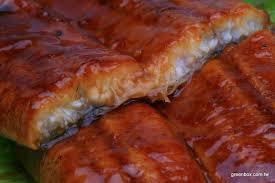
BBQ eel (Unagi) 野生活燒饅- Pack(8-8.8 oz)
Unagi - The Secrets Of Japanese Grilled Eel
When it comes to grilling fish, the Japanese have mastered the art. Which should hardly be surprising, when at least according to the Guardian "one in ten fish is eaten in Japan. " As a culture Japan has explored the eating of fish to levels quite literally never even thought of yet in the west. We have plenty of sushi bars in the States, but the food served at most American sushi bars is a very narrow range of possible selections you could make of Japanese fish dishes.
 The cooking process is what makes the eel both crisp and tender: The eel is first grilled over hot oak charcoal, then steamed to remove excess fat, then seasoned with a sweet barbecue like sauce and grilled a second time.
The cooking process is what makes the eel both crisp and tender: The eel is first grilled over hot oak charcoal, then steamed to remove excess fat, then seasoned with a sweet barbecue like sauce and grilled a second time.
I think of sushi as pretty normal these days, I have been eating it since I was a young person. However I regularly meet people who have never had it and often meet people who are repulsed at the thought of eating what has been described to them (incorrectly) as raw fish. I think that this knee jerk aversion probably stems from the fact that so many Americans have had such a narrow range of exposure to eating fish generally. Many of the types of food served at a sushi bar are, in fact, cooked. and today's exploration is of just one such fish - in this case freshwater eel.
This is where I lose a lot of folks when trying to introduce sushi to a newcomer. I promise them that we will stray away from all but one or two pieces of raw fish based sushi and instead introduce them to the cooked pieces. We start with California Roll - perhaps the least innocuous and non-strange kind of sushi imaginable. Then we move on to something like shrimp tempura roll, to help them come full out from hiding. Then we hit unagi - This is a make or break moment for some. I like to have them try it before I tell them it is eel; but for the more squeamish this tactic invariably fails.
I think its because eels look like snakes, but folks sure don't like the idea of eating them if they are strictly used to fish and chips, and the occasional shrimp cocktail.
You have to understand, grilled unagi is an absolute delicacy in Japan, popular not only for its flavor but also for its reputed "stamina-giving properties".
If I get them past a piece of grilled unagi, it's a slippery slope from there to an all out love affair with sushi. I can still remember the day that my father - the first person I ever introduced to sushi - pronounced that sushi was the only proper way to serve fish. I don't totally agree with that sentiment, and I don't think he does either but there sure is a lot that we can glean from the Japanese fish cooking traditions.
The Perfect Grilled Fish
Unagi is traditionally eaten during one of the hottest days of the summer and is said to help provide strength and vitality for the rest of the year.
Well cooked unagi combines a rich flavor (described by some as a bit like pate) with an appealing texture, crisp on the outside but moist and tender on the inside. The cooking process is what makes the eel both crisp and tender: The eels are first grilled over hot charcoal (oak is supposed to be the best wood for this process), then steamed to remove excess fat, then seasoned with a sauce reminiscent of a teriyaki style barbecue sauce, and grilled a second time which caramelizes the sauce and crisps the skin and outside of the fish.
 Grilled unagi on skewers without rice is called kabayaki, and it's often served as an hors d'oeuvre with drinks. This same grilled unagi is also served over a bed of rice as a main course, called either unajuu or unagi donburi
Grilled unagi on skewers without rice is called kabayaki, and it's often served as an hors d'oeuvre with drinks. This same grilled unagi is also served over a bed of rice as a main course, called either unajuu or unagi donburi
Like barbecue in the States the ingredients in the sauce which the fish is basted in is important to the final taste of the unagi, and different restaurants have their own secret recipes.
The big surprise to a lot of Americans (certainly a surprise to me) is that unagi isn't always served in one and a half ounce portions on fingers of rice; no, Unagi is mostly served in largish pieces called Unagi Kabayaki and even more important - you can get Unagi - in several forms, here in the States, if you are willing to fire up your grill.
The most common way to get Unagi is frozen, and partially precooked. The fish has been grilled, steamed and sauced and is ready to be put on your grill or in your broiler. The fish is sold in a variety of weights, and qualities, but a 9 to 10 ounce piece will generally cost you an astounding price of about $4.50. This is probably only shocking to Americans who are used to paying 5 or 6 bucks for two tiny little pieces of this fish served up on finger sized pieces of rice.
 Like barbecue in the States the ingredients in the sauce which unagi is basted in is important to the final taste of the unagi, and different restaurants have their own secret recipes; and like barbecue sauce, you can find several kinds at the local asian market here in the States, if you know what you are looking for.
Like barbecue in the States the ingredients in the sauce which unagi is basted in is important to the final taste of the unagi, and different restaurants have their own secret recipes; and like barbecue sauce, you can find several kinds at the local asian market here in the States, if you know what you are looking for.
Unagi Dishes
Grilled unagi on skewers without rice is called kabayaki, and it's often served as an hors d'oeuvre with drinks. The same grilled eel is also served over a bed of rice as a main course, served this way it is called either unajuu or unagi donburi. Eel is also grilled without sauce as shirayaki. This plain form of eel is popular with unagi purists, who believe that the sauce covers poor fish and cooking skills.
When you order a full-course eel meal in Japan you may also be served kimosui, a clear soup made from eel livers. The livers are reputably very nutritious, although rumor has it that not everyone particularly enjoys the taste.

